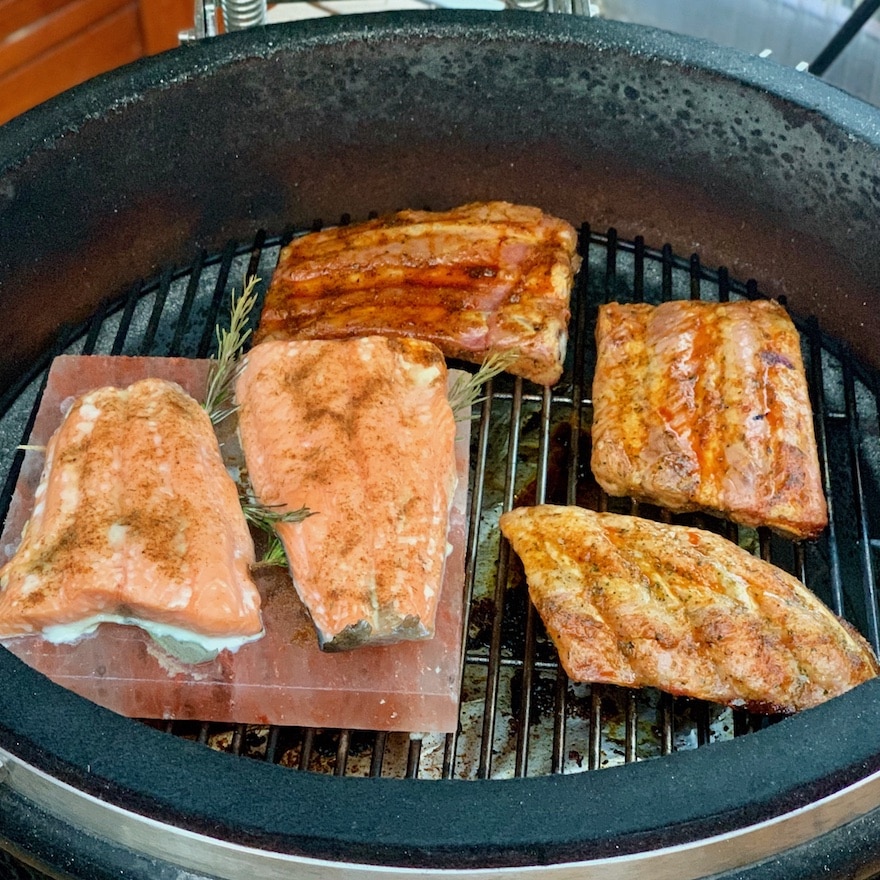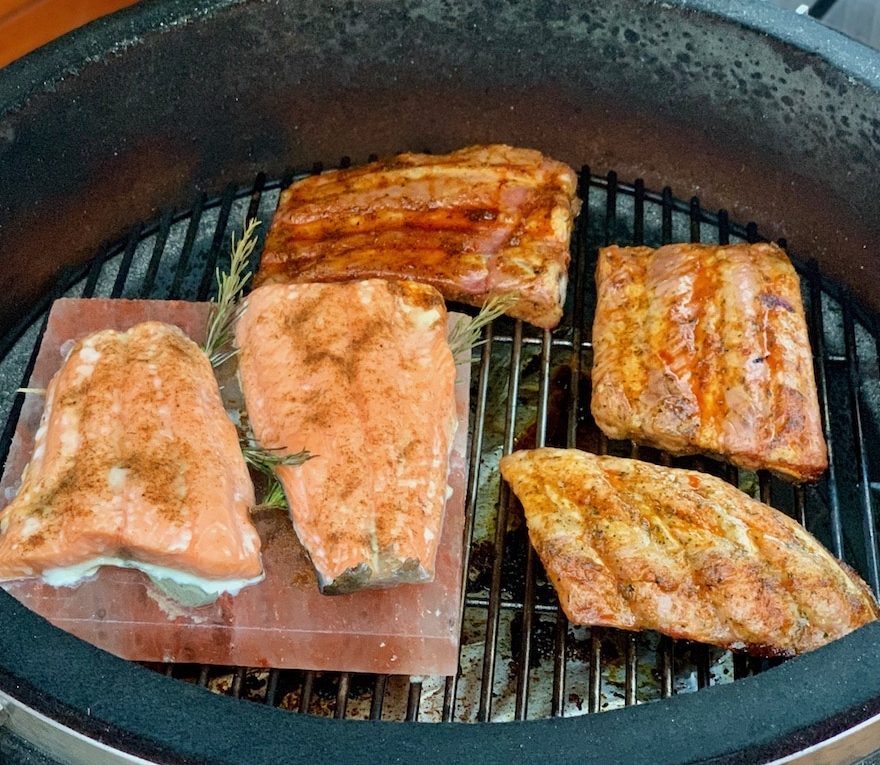Grilling with the salt stone

There are different types of salt blocks. Naturally, there are significant differences in quality, especially regarding durability and taste. Here’s all you need to know about salt blocks and some great tips for grilling with them.
Grill enthusiasts are usually adventurous and open to new things in the grilling world. Salt blocks are gaining more attention, offering a welcome change and opening up new cooking possibilities. Salt blocks are also referred to as salt slabs or salt planks.
Himalayan salt blocks, in particular, are reputed to be beneficial for health. A salt block made of authentic Himalayan salt isn’t white as expected but has a slight pink hue. This comes from minerals and trace elements deposited over millions of years. In contrast to regular salt, Himalayan salt blocks contain over 80 of these elements, which spread through the food during grilling. After consuming the grilled food, these elements allegedly unleash their health benefits in the body, such as improved digestion, aiding with heartburn, and enhancing the body’s pH balance regulation. At the same time, the minerals and trace elements give the grilled food an unparalleled taste that can’t be achieved with regular salt.
What is a salt block?
Salt is compressed into salt deposits by the Earth’s masses over millions of years, making it very hard. It’s then mined from depths of 400 to 900 meters. Due to its high heat resistance, it’s excellent for baking or grilling. For commercial purposes, specific plates are cut from the salt block. Typical sizes range from 20×10 to 20×20 cm, with thickness varying between 2.5 and 5 cm. A salt block measuring 20x20x2.5 cm weighs approximately 2.2 kg. Prices range from 10 to 30 euros. You can identify a salt block with a good price-performance ratio in our salt block comparison.
Grilling on a salt block is becoming more trendy year by year. This grill accessory impresses with its delightful aroma on the grilled food. So, we’re diving into this topic to introduce you step by step to the world of grilling on a salt block. One thing is certain: this block brings a lot of variety to the grill. Salt blocks can be used on gas grills as well as charcoal grills. You can find salt blocks in various shapes and sizes. It allows for low-fat grilling on every model. You don’t need to worry about dripping fat. You can cook on it indirectly or sear directly in high heat.
Informative details about grilling with salt blocks
Naturally, we’d like to impart some knowledge about salt blocks to you. Salt blocks are extremely hard because they’ve been compressed by Earth’s masses over millions of years. They are primarily mined from depths of 400 to 900 meters. Salt blocks tolerate heat exceptionally well, making them suitable for grills and ovens. In the market, you’ll mainly find salt slabs sized 20 x 10 or 20 x 20 cm. The slabs vary in thickness from 2.5 to 5 cm. Price-wise, they are quite affordable, ranging from 10 to 30 euros depending on size and thickness.
Original Himalayan salt blocks might be slightly more expensive. They exhibit a light pink coloration due to over 80 minerals and trace elements deposited in them over millions of years. Consequently, they’re considered health-promoting. When grilling or baking on a Himalayan salt block, you’re contributing to your health. These elements are partly absorbed by the grilled food, enhancing the unique taste of the food. It’s believed to alleviate complaints such as heartburn or digestive issues and improve the body’s pH balance regulation.
Grilling on a salt block is healthy
It’s reassuring that the surface is antibacterial, eliminating concerns about bacterial contamination on the grilled food. Being able to do without oil and fat is a significant plus point. So, grilling on a salt block is genuinely healthy. Additionally, the grilled food absorbs trace elements and minerals from the salt.
Clear advantages
Fundamentally, the salt block enhances the taste. It’s highly positive that grilling on the stone allows you to abstain from using fat and oil, which is beneficial for health and weight. Just place the food directly on the salt block.
The block can be heated to a high temperature, but it shouldn’t be done too quickly. Avoid placing it directly in high heat, as this could cause it to crack. It takes almost three-quarters of an hour to reach the desired 400°C through careful heating – or at least it should! The food absorbs the salt excellently. The standard size of a block is usually 20 x 10 x 3 cm and available in grill specialty stores and online shops.
It’s possible to lay several blocks side by side to create a larger grilling surface. This is practical when preparing larger fish. Check out our salt block comparison for more information on this.
Tasty grilling with the salt block
A variety of dishes can be successfully cooked on a salt block. Salmon and other fish, as well as seafood, taste delicious, as do chicken, steaks, and various vegetables. The distinctive feature is the fine salt crust that forms while grilling. No need to worry about dripping fat. However, there’s something important to note: the wetter your food, the saltier it will become.
Temperature also plays a significant role. If the food is placed on a block that’s still too cold, it can absorb excessive salt. To prevent an overly salty taste, it’s recommended to thoroughly pat dry the food before grilling.
Experiment with flavors to suit your taste, as not everyone prefers the same level of saltiness. You can easily test if the salt block is hot enough. Drop a small amount of water on the block; if it evaporates quickly, the right temperature has been reached.
What food is suitable for grilling on the salt block?
Using a salt block for grilling rewards you with a delicious aroma. But what can be grilled on it? Essentially, almost anything. Steaks grill wonderfully on it. Filet medallions are particularly enjoyable for us. Sliced poultry breast can be grilled tender and crispy as thin fillets. Fish and seafood taste delightful as the delicate salt flavor complements them perfectly. Grilled salmon on the salt block is a real delicacy. Vegetable lovers also benefit from it. Just experiment. The crucial thing is always to ensure your food can sit flat. This is the ideal condition for grilling on a salt block.
If you want to grill very large steaks or fish, simply place multiple salt blocks side by side. Grilling directly on the salt block crisps the food but can burn if grilled for too long. Our grilled food isn’t seasoned before placing it on the block. Otherwise, other spices would mask the truly special salty flavor. This flavor is incomparable to regular table salt. Experimenting with grilling on the salt block is worthwhile and allows you to discover what suits your taste best.
Tip:
We generally don’t place marinated food on the salt block. The marinade would seep deep into the salt block and quickly salt the food through the wet marinade. The block would absorb the taste of the marinade and release it during the next grilling session.
How to properly use salt blocks when grilling?
Simply placing salt blocks in high heat for grilling won’t work. We’ll explain in simple steps how to handle a
salt block when grilling. Don’t rush; these stones don’t become grill-ready in a matter of seconds.
Preheat the grill. This applies to all types of grills, so whether it’s charcoal or gas doesn’t matter.
When grilling, never place the “dry” salt block directly in the high heat. Always place it on the edge of the grill, in the indirect heat zone. Place it while the grill is still cold. This way, it gradually absorbs heat as the grill heats up.
After about 20 to 30 minutes, you can slowly move it towards the direct heat zone. Move it step by step, allowing for short breaks of a few minutes each time.
It takes about 30 to 45 minutes for the block to reach its ideal grilling temperature. At about 400°C, it’s ready for grilling.
You can easily determine if the salt block has reached the right temperature. If a drop of water evaporates quickly on the block, you can finally place the food on it.
How to properly clean and store the salt block after grilling?
The salt block should not be thoroughly cleaned immediately after grilling. Wait until it has completely cooled down, which takes between one and two hours. Do not put it in the dishwasher, and it doesn’t like dish soap or running water either. Clean the block with a sponge or a relatively soft brush. If it gets too wet during cleaning, it will lose thickness over time and eventually become too thin for grilling.
Under no circumstances should you put it in the dishwasher. Dishwashing liquid is also not suitable for the salt block. Running water generously over it is also not advised. Once the block comes into contact with water, it will lose thickness, which is bad for its lifespan!
You can remove stubborn dirt first with a wooden scraper. If that’s not sufficient, a damp sponge or brush is suitable for removing the remaining residue. By avoiding water on the salt block, you’ll naturally increase its lifespan.
It’s important to store it in a dark, dry, and cool place. This place must be food-safe. Don’t store it next to cleaning agents or strongly scented foods, such as onions and garlic.
Tip:
You can easily control how strong your grilled food tastes of salt. Wet food absorbs salt more strongly. It also becomes saltier if placed on the cold block.
Do salt blocks really crack? Fact or fiction?
You might have heard or read about salt blocks cracking in the media. This isn’t just a rumor. However, it’s essential to understand the reason behind it. When a salt block breaks, it’s usually due to incorrect usage. Salt blocks store heat excellently, which is a significant advantage while grilling. However, they can’t tolerate extreme temperature fluctuations or being heated while damp. The consequence can be stress cracks.
Don’t rush when heating your block to the desired temperature. This is due to the gas contained in the salt due to crystal water. If heated too quickly, the pressure from the gas can cause the salt block to crack. Please follow our instructions for proper heating of a salt block. When done correctly, nothing should happen to the salt block.
Where to find the ideal salt block for successful grilling?
We find it convenient not to spend time searching for salt blocks in various stores in the city. That’s why we always order our salt blocks online. Other advantages of online ordering for us include:
No opening hours to adhere to.
A wide range of qualities, prices, and sizes.
Buyer reviews often make the choice easier.
Salt blocks are available from various brands like Santos, Don Marco’s Barbecu, Salz-Helmreich GmbH, Charcoal Companion, Salz Einkaufsparadies, AGT Salzwelten, INDUSAL, and Rekosan.
Our Conclusion
We’ve been grilling on salt blocks for quite some time now. This salty accessory is indispensable in our grilling. It has excellent heat retention and an antibacterial surface. Our Sandra is particularly thrilled about the possibility of preparing fresh vegetables on it without added fat. Additionally, valuable minerals are transferred to the grilled food. So, you don’t have to be a meat enthusiast to use the salt block in your next grilling session
It’s really worthwhile to experiment with various meat types on the salt block. In our grilling meat guide, you’ll surely find many types of meat that can benefit from the salty aroma. Price-wise, salt blocks are definitely affordable for you. We always appreciate comments and user experiences. For more information, check out our salt block test and comparison.
